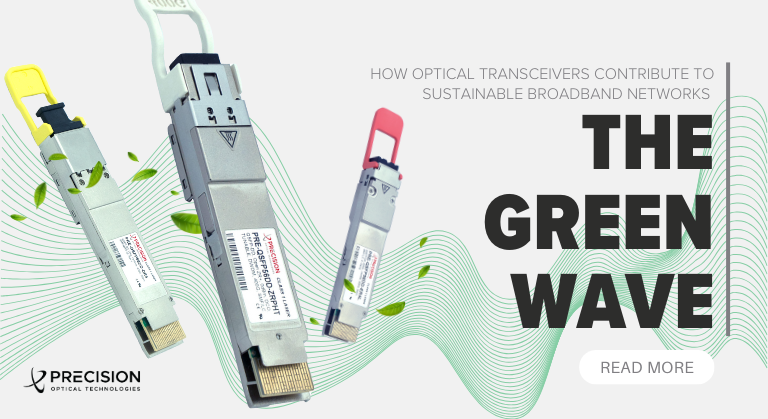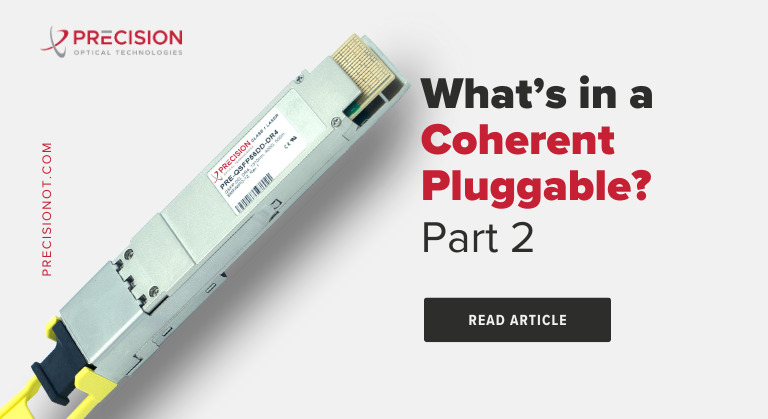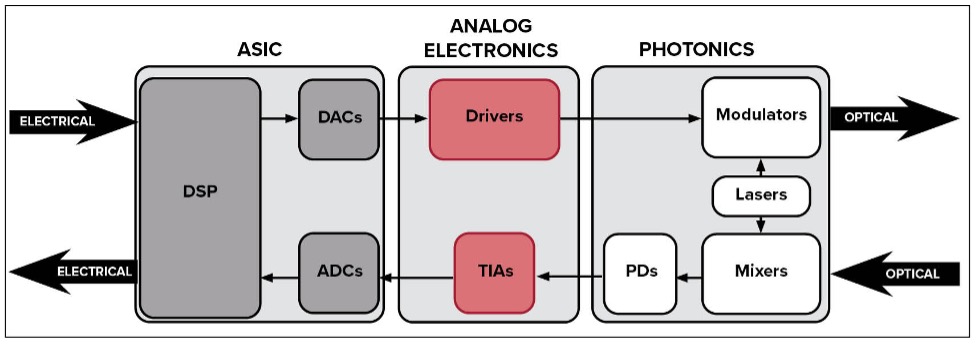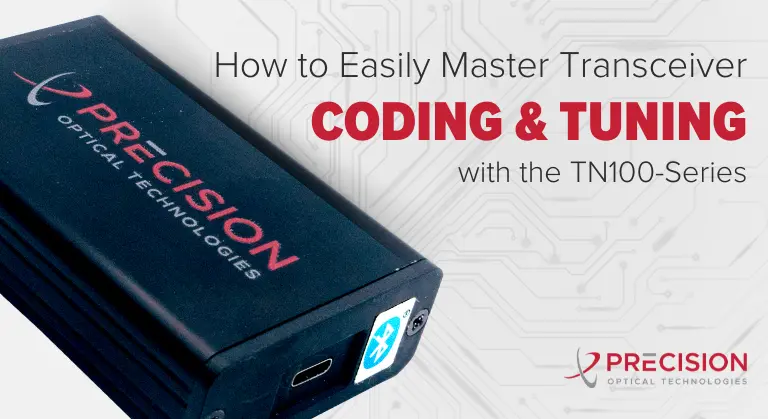
What’s In a Coherent Pluggable? Part II

In Part I, we discussed the impact coherent pluggables are having on modern optical networks and learned the basics of coherent communication. An explosion of coherent technology advancement in recent years has involved novel modulation schemes and various methods to increase data rate. In Part II, we’ll discuss error correction techniques which further improve performance and industry standards which help ensure interoperability, performance, and compatibility.
Error Correction Techniques for Coherent Pluggables
As we’ve discussed previously, error correction techniques have been part of long range data transmission systems for many years and they’ve become even more relevant with the arrival of 400G pluggable optics. In Forward Error Correction (FEC), redundant information known as “parity bits” is added to the original data stream before transmission. These parity bits are calculated based on the original data using mathematical algorithms, such as Reed-Solomon codes, convolutional codes, or LDPC (Low-Density Parity-Check) codes. The redundancy introduced by FEC allows the receiver to reconstruct the original data even if some errors occur during transmission.
Different types of FEC have been used in optical communications for various data rates and applications. In the current environment of Coherent pluggables, the main FEC types are:
- Concatenated FEC (C-FEC)* – used in the 400ZR standard
- Open FEC (O-FEC) – part of the OpenROADM and OpenZR+ specifications
- Staircase FEC (SC-FEC) – used for the 100GBASE-ZR standard
*we have often seen OpenZR+ capable modules that also support OIF 400ZR mode(s) of operation — when in that/those mode(s), cFEC is used
The use of one FEC or the other will depend on the application and technology possibilities within the confines of a certain form factor. For example, O-FEC is a stronger coding algorithm, which can handle a higher rate of errors and make a pluggable able to reach longer distances. However, that comes with the drawback of a higher amount of data processing needed within the DSP of the transceiver, which in turn relates to more power consumption and heat dissipation. As a practical example, a 400G coherent pluggable using an application of 400G C-FEC vs the same transceiver working at 400G O-FEC can have a difference of 3W more power consumed when using the latter.
Coherent Pluggable Standards
Coherent pluggables must adhere to various industry standards to ensure interoperability, performance, and compatibility with existing optical communication systems. Some of the key standards that govern the design, manufacturing, and deployment of coherent pluggables include:
i) OIF (Optical Internetworking Forum) – OIF develops interoperable networking specifications that address the needs of the industry. OIF standards include those related to optical specifications, module management, electrical interfaces and networking protocols amongst others. The OIF was the organization that lead the 400ZR Implemenation Agreement to success and has been organizing several plugfests and demos over the last few years to demonstrate the industry adoption and the great success of the 400G coherent pluggable ecosystem.
- ii) OpenROADM – The OpenROADM MSA group defines and promotes Open API models and optical specifications to create an ecosystem that promotes vendor interoperability, reduces vendor lock-in, and lowers the total cost of network ownership.
iii) Open ZR+ is an interoperable optical module standard developed by the OpenZR+ MSA (Multi-Source Agreement) group. It was created as an evolution and addition to the 400ZR and OpenROADM specifications. It aims to define a common specification for coherent optical transceivers. While Open ZR+ defines its own specification, it also ensures compliance with relevant industry standards, such as IEEE (Institute of Electrical and Electronics Engineers) and ITU-T (International Telecommunication Unio – Telecommunication Standardization Sector), to facilitate interoperability and compatibility with existing network infrastructure.
iv) CMIS (Common Management Interface Specification) – is a management interface for optical modules and cable assemblies. It provides a defined set of registers and functions for standard module management between hosts and transceivers.
v) 100G-ZR Standards – IEEE 802.3ctTM (100GBASE-ZR) and ITU-T G.698.2 (DP-DQPSK 100G). The IEEE 802.3ctTM is an amendment aimed at addressing the needs of networks requiring up to ~80km reach where lack of fiber availability drives the need to use one fiber to transmit multiple instances of Ethernet. IEEE 802.3ctTM will enable up to 48 wavelengths on a single fiber, with each wavelength supporting transmission of a separate 100 Gb/s Ethernet data stream. ITU-T G.698-2 is a revised ITU standard for “Amplified multichannel DWDM applications with single channel optical interfaces”. It supports a phase-modulated signal using DP-DQPSK (Dual Polarization – Differential Quadrature Phase-Shift Keying).
Coherent Pluggables: What’s Inside?
At a high level, the inner workings of a coherent pluggable contain an optical engine with three primary components as shown in Figure 1.
Figure 1 High Level Schematic of Coherent Optical Engine
A more detailed view of the typical components within a coherent pluggable is shown in Figure 2, including polarization control, modulators, oscillators, drivers, TIAs, laser and photodetectors (PDs). Most coherent transceivers will have very high-speed Digital-to-Analog (DAC) and Analog-to-Digital (ADC) Converters and a Digital Signal Processor (DSP) which serves as the digital “brain” of the optical communication system, performing advanced data processing to maximize the capacity, reach and reliability of high-speed transmission. All of these cutting edge components represent years of R&D and investment that went into developing the technologies.
Figure 2 More Detailed View of Coherent Optical Engine
While Figure 2 above represents a generic Coherent transceiver, some other components may be required depending on the transceiver type. For example, a small amplifier embedded in the photonics design for higher TX output power applications, and a tunable optical filter for pluggables that have that capability.
Precision OT’s Coherent Pluggables:
Precision OT’s coherent pluggable portfolio includes different options in the most common form factors: QSFP-DD and QSFP28. Each product can serve a different application or range of applications depending on the customer host and network architecture needs.
- i) PRE-QSFP56DD-ZR – This product is the standard transceiver that meets the OIF 400ZR IA:
- Single rate 400G
- DP-16QAM
- C-FEC
- Tunable C-band DWDM
- ~ -10 dBm TX power
- Reach:
- Up to 40km unamplified
- Up to 120km with amplification
- ii) PRE-QSFP56DD-ZRHT – Similar to the regular 400G ZR, except with an improvement on the standard to enable use with legacy optical amplifiers which require a higher transmit (HT) power, or for longer reach in unamplified links.
- Single rate 400G
- DP-16QAM
- C-FEC
- Tunable C-band DWDM
- ~ 0 dBm TX power
- Reach:
- Up to 80km unamplified
- Up to 120km with amplification
- iii) PRE-QSFP56DD-ZRXT – A customized and unique solution that enables 400G up to 120km on unamplified point to point links.
- Single rate 400G
- DP-16QAM
- C-FEC
- Fixed DWDM ITU ch. 37
- ~ +4 dBm TX power
- Reach: Up to 120km unamplified
- iv) PRE-QSFP56DD-ZRP – This soon to be released optic is the standard pluggable transceiver that meets both the Open ZR+ and the OIF standards.
- Multi-rate 400G-100G
- DP-16QAM/8QAM/QPSK
- O-FEC/C-FEC
- Tunable C-band DWDM
- ~ -10 dBm TX power
- Reach:
- Up to 40km unamplified
- Up to 480km with EDFA only / 1000 km with Raman/EDFA hybrid
- v) PRE-QSFP56DD-ZRPHT – Next generation of 400G ZR+ optics with higher transmit power to accommodate brownfield networks that require similar TX power input into their OLS systems compared to their existing configuration.
- Multi-rate 400G-100G
- DP-16QAM/8QAM/QPSK
- O-FEC/C-FEC
- Tunable C-band DWDM
- ~ 0 dBm TX power
- Reach:
- Up to 80km unamplified
- Up to 480km with EDFA only / 1000 km with Raman/EDFA hybrid
- vi) QSFP28 100G ZR Coherent – Coming Soon…….
The industry has long been awaiting an access/edge solution to enable 100G DWDM interfaces without having to invest in expensive transport equipment or higher cost switches or routers with QSFP-DD ports. Coming soon is the first coherent transceiver available in a standard QSFP28 form factor. It will be deployable in nearly all legacy host devices.
Features of the QSFP28 100G ZR Coherent include:
- 100GbE/OTU4
- DP-DQPSK
- SC-FEC
- Tunable C-band DWDM
- Externally tunable using Precision’s exclusive TN100-QDD Tuning Module
- Reach:
- Up to 80km unamplified
- Up to 300km with amplification and dispersion compensation
- <5.5W power consumption
- SFF-8636 Compliant
What Precision OT Brings in addition to Coherent Pluggables:
We have a track record of providing a hands-on approach to replicating networks, maintaining reliability, and providing the highest level of service. At Precision OT we:
- Ensure fully interoperable and compatible coherent modules while avoiding vendor-locked/proprietary DSP based optics
- Follow industry standards for 400ZR, OpenZR+, 100G ZR, SFF and CMIS approved documents and agreements
- Perform multi-platform host system integration and compatibility
- Test minimum host SW version releases for full functionality
- Provide supply chain diversity of all coherent modules
- Participate in industry wide standardization groups, plugfests and demos to keep up to date with the latest developments in network technology








